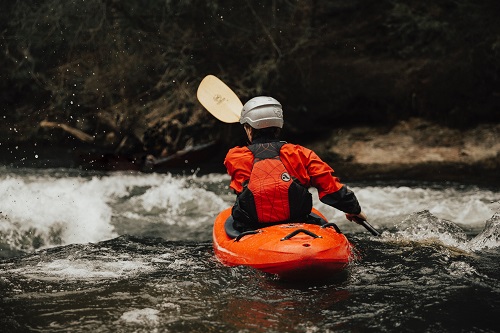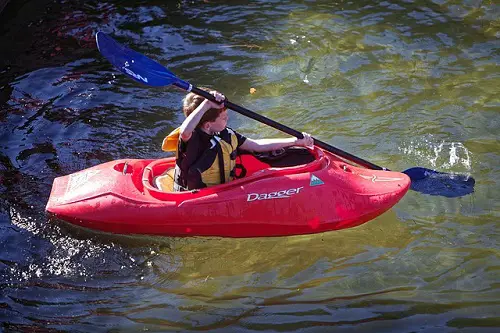Whitewater kayaking is a fun and exciting sport. But with all the gear and skills it requires, it can seem complicated to get started. One of my friends wanted to get into whitewater kayaking a few years ago, so I introduced him to it. But what if you don’t know anyone that paddles in rapids yet?
Hi, I’m Sacha Parent, and my dad used to have a whitewater kayaking school. I have watched him teach beginners to start getting comfortable in the water since I was a kid. So I know a lot about getting into this water sport. Now let me share with you where to get started!
The best way to get into whitewater kayaking is to take an introduction class. Your kayak instructor will help you learn the basics and start paddling on the river. Then, you can also join a local whitewater kayaking club. After that, you must go on the water, practice, and improve your paddling skills.

If you have a friend already doing whitewater kayaking, you can also ask him to introduce you to it. But keep in mind that it’s not because a person knows how to do something that he can teach it to someone else. That’s why taking lessons from a qualified kayak instructor is generally a better idea.
But it’s not that simple, and it may take quite some time before you get comfortable paddling in whitewater. So let me help you make it as easy as possible. Here are 7 steps to start kayaking in rapids!
1. Take Whitewater Kayaking Lessons!
If you want to learn how to kayak in whitewater, you need someone to teach you. You can always ask a friend to introduce you to kayaking, but it won’t be as good as a proper lesson with a qualified instructor. So please do yourself a favor by investing in a class.
Taking some lessons will allow you to learn the basics and have time to practice. Your instructor will teach you how to paddle properly and get used to a whitewater kayak. Then, you will probably learn some fundamental techniques, such as different strokes, edging, bracing, and capsize rescues.
Find A Whitewater Kayaking Class!
To find places to get started, you can simply type something like “whitewater kayaking classes or lessons near me” on Google or any other search engine. You should see a few different venues where you can learn to kayak in a river close to your location. Another way to find instructors is to look at the listing of an organization such as the American Canoe Association. (ACA)
ACA Instructors Listing (Select River Kayaking Level 1)
Here’s what to expect! Most beginner classes will last between 2 and 4 days. An instructor will teach you the basics along with other paddlers. Then, you will have time to practice in flatwater and improve your paddling skills. After that, you will be introduced to whitewater, start kayaking in it, and probably get on your first river trip!
In general, a whitewater kayaking class will cost around $500. The Wet Planet 3-Day Immersion Class is an excellent example to check out and consider if you’re located near White Salmon, WA. So the first step to get into whitewater kayaking is to take lessons.
2. Join A Paddling Club!
Once you know how to kayak and you’re hooked on paddling in whitewater, it’s time to join a club. You can also do it before you start kayaking, but I recommend getting your feet wet first. Then, you will be ready to join a community of whitewater paddlers.
Having a group of experienced kayakers in your network is an excellent idea, especially if you just got started. It will help you find people to paddle with and learn from them. Just make sure you bring something to the table and respect the rules.
Finding a paddling club isn’t that difficult. You can search for “whitewater kayaking clubs near me” on Google and hopefully get a few results. The American Whitewater Organization also has a local club listing in the US. Then, you can also look for whitewater kayaking groups on Meetup!
3. Gear Up!
If you want to get into whitewater kayaking, you will need the right equipment. It’s essential to have fun and be safe on the river. If you’re on flat water, you might only need a kayak, a paddle, and a personal flotation device.
But once you’re ready to go down rapids, you should always wear a helmet and a spray skirt. Getting them right off the bath isn’t a bad idea to get used to them as soon as possible.
You might also want to invest in a few accessories, such as a nose plug, waterproof bag, wetsuit, knife, and whistle, to make your paddling adventures even more enjoyable and safe. I love having a nose plug when kayaking to avoid getting water in my nose if I flip over and roll.
But don’t worry. You don’t need to have and buy all that gear at the start. If you’re joining a class, you will get all the equipment necessary. And after that, you can borrow what you need from a friend or a club member. Renting kayaking gear is also another good cheap alternative for beginners.
Then, once you’re fully hooked and know what you need or want, you can buy your equipment. Just make sure to choose the right whitewater kayak. It will mainly depend on the water conditions you plan to go in and what you want to do there.
After that, it doesn’t matter which paddle, PFD, helmet, spray skirt, and other accessories you get. As long as it’s the right size and adapted to whitewater kayaking, everything should be fine.
4. Learn To Capsize & Perform A Wet Exit!
The first step to start whitewater kayaking is preparing for when your kayak will flip over. Even though you should learn it during your lessons, you still have to practice. And if you decide not to take a class, here are the basics.
First of all, you have to become comfortable being underwater upside down. The more you capsize, the less scary and panicking it will get. You must be able to stay calm and keep your breathing as long as possible.
Then, your first reaction when capsizing in whitewater should be to bend over and keep your upper body as close to your kayak as possible, especially your head. You don’t want to get knocked out by hitting a rock when you’re stuck underwater in your boat. So even if you don’t paddle in rapids yet, you should still develop that reflex.
Once the water gets calmer and deep enough, you can perform a wet exit. It simply consists of taking your spray skirt and getting out of your kayak underwater. After that, you must swim to land, empty your boat, and relaunch from there.
5. Kayak On Flat Water!
Before you start kayaking in rapids, you should improve your paddling skills in the safest and easiest environment possible. That’s why even if your goal is to go in whitewater, you should begin on flat and calm water. It will be much better for practicing your different paddle strokes and learning to navigate a kayak.
Most whitewater kayaking schools will make beginners start in flat water. So you should do the same. A small lake or a calm part of a river would be perfect. Just don’t start in big rapids where you won’t be able to learn anything and probably end up hurting yourself.
Here’s what you should know before using a whitewater kayak in flat water!
6. Go Down Your First Rapid!
Once you know how to recover from a capsize and have some paddling experience on flat water, it’s time to go in whitewater. You should ideally start with a very small and safe rapid. It’s also an excellent idea to do it with someone with good kayaking skills.
Look at the rapid together and figure out which line is the safest and easiest. With time, you will learn to read a river and understand how to do this better. Once you know where to go, it’s time to gear up, go on the water, and have fun.
Try to stay in the line you decided as much as possible and keep paddling. Having your paddle in the water will give you more control and stability. And if you flip over, don’t panic. You know what to do and are ready for it. (Well, you’re supposed to be!)
7. Learn To Roll & Improve Your Paddling Skills!
When you know the basics and can go down rapids, you should improve your paddling skills. There’s no secret, it’s all about practice. The first game-changer is learning to roll. It’s a technique to recover from a capsize without the hassle of performing a wet exit and relaunching.
Here’s how to do it. First, you place the paddle on the side of the kayak flat on the water. Then, you move the front blade as far as possible from the boat at the surface. After that, you pull the paddle as support and use your hips to turn the kayak back up while leaning backward.
It might seem easy and simple, but learning to roll will probably take a lot of time. That’s why I highly recommend taking an advanced class or lesson to master that skill. It makes kayaking much more fun.
Apart from rolling, there are many other things you can work on while paddling in whitewater. You should try to stop as often as possible on the side of the rapids where it’s possible. Then, you can also improve your reading of the river, learn about all the features, and start playing in them.
Last Thoughts About Starting Whitewater Kayaking!
Finally, getting into whitewater kayaking isn’t that complicated. You just need to take lessons, join a club, gear up and practice your paddling skills on flat water until you can go down rapids. It might take some time to get there, but it will be worth all the fun you will have on the river.

Don’t hesitate to ask for help along the way too. Most paddlers would be happy to give a hand to someone that’s getting started. We all have been there. As long as you’re ready to put in the work, I’m sure you can kayak in whitewater. Now it’s time to take action and go on the water.
Let’s Get Into Whitewater Kayaking!
